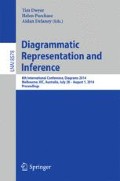Abstract
Although diagrams have been shown to be effective tools for promoting understanding and successful problem solving, students’ poor diagram use has been identified as a serious issue in educational practice-related reports. To enhance students’ diagram construction skills and to address problems in diagram use, creating learning situations that make it inevitable for students to use diagrams would likely be helpful. To realize this, communicative learning situations can be considered a viable option, as students would feel a greater necessity to use diagrams as a consequence of feedback they receive while explaining. Thus, this study examined the hypothesis that an interactive peer instructional learning situation would better promote students’ spontaneous diagram use compared to a non-interactive situation. Eighty-eight university students were randomly assigned to one of two conditions: interactive and non-interactive. After reading a passage relating to the science and engineering area, participants in the interactive condition were requested to explain the content of the passage to another participant next to them. In contrast, participants in the non-interactive condition were asked to record an explanation using an IC recorder by imagining that they were explaining to another person. A sheet of paper was provided to participants during the explanation, and diagram use on the paper was analyzed. The results revealed that students’ diagram use in the interactive condition was higher than in the non-interactive condition. This indicates that teachers’ provision of interactive communication situations can effectively promote students’ likelihood of using diagrams spontaneously.
Access this chapter
Tax calculation will be finalised at checkout
Purchases are for personal use only
Preview
Unable to display preview. Download preview PDF.
References
Ainsworth, S., Prain, V., Tytler, R.: Drawing to Learn in Science. Science 333, 1096–1097 (2011)
Larkin, J.H., Simon, H.A.: Why a Diagram is (Sometimes) Worth Ten Thousand Words. Cognitive Science 11, 65–99 (1987)
Stern, E., Aprea, C., Ebner, H.G.: Improving Cross-content Transfer in Text Processing by Means of Active Graphical Representation. Leaning and Instruction 13, 191–203 (2003)
Butcher, K.R.: Learning from Text with Diagrams: Promoting Mental Model Development and Inference Generation. Journal of Educational Psychology 98, 182–197 (2006)
Mayer, R.E.: Multimedia Learning. Cambridge Univ. Press, New York (2001)
van Essen, G., Hamaker, C.: Using Self-Generated Drawing to Solve Arithmetic Word-Problems. Journal of Educational Research 83, 301–312 (1990)
Hembree, R.: Experiments and Relational Studies in Problem-solving: A Meta-analysis. Journal for Research in Mathematics Education 23, 242–273 (1992)
Uesaka, Y.: Suugakuteki mondaikaiketu ni okeru zuhyou katuyou no shien (Supporting Students’ Use of Diagrams in Mathematics Problem Solving: Development of the “REAL Approach” which Connects Theories and Practices). Kazamashobo, Tokyo (2014)
Dufour-Janvier, B., Bednarz, N., Belanger, M.: Pedagogical Considerations Concerning the Problem of Representation. In: Janvier, C. (ed.) Problems of Representation in the Teaching and Learning of Mathematics, pp. 110–120. Erlbaum, Hillsdale (1987)
Uesaka, Y., Manalo, E., Ichikawa, S.: What Kinds of Perceptions and Daily Learning Behaviors Promote Students’ Use of Diagrams in Mathematics Problem Solving? Learning and Instruction 17, 322–335 (2007)
Uesaka, Y., Manalo, E., Ichikawa, S.: The Effects of Perception of Efficacy and Diagram Construction Skills on Students’ Spontaneous Use of Diagrams When Solving Math Word Problems. In: Goel, A.K., Jamnik, M., Narayanan, N.H. (eds.) Diagrams 2010. LNCS, vol. 6170, pp. 197–211. Springer, Heidelberg (2010)
Chan, L.K.S.: Combined Strategy and Attributional Training for Seventh Grade Average and Poor Readers. Journal of Research in Reading 19, 111–127 (1996)
Brown, A.L., Bransford, J.D., Ferrara, R., Campione, J.A.: Tetrahedral Framework for Exploring Problems of Learning. In: Flavell, J.H., Markman, E.M. (eds.) Handbook of Child Psychology, 4th edn. Cognitive Development, vol. 3, pp. 85–106. Wiley, New York (1983)
Ueki, R.: Structure of High-School Students’ Beliefs About Learning. The Japanese Journal of Educational Psychology 50, 301–310 (2002)
Shinogaya, K.: Effects of Preparation on Learning: Interaction With Beliefs About Learning. The Japanese Journal of Educational Psychology 56, 256–267 (2008)
Lyon, J.: Drawing: Its Value as a Communication Aid for Adults with Aphasia. Aphasiology 9, 33–50 (1995)
Sacchett, C.: Drawing in Aphasia: Moving Towards the Interactive. Human-Computer Studies 57, 263–277 (2002)
Palincsar, A.S., Brown, A.L.: Reciprocal Teaching of Comprehension-fostering and Comprehension Monitoring Activities. Cognition and Instruction 1, 117–175 (1984)
Manalo, E., Uesaka, Y.: Elucidating the Mechanism of Spontaneous Diagram Use in Explanations: How Cognitive Processing of Text and Diagrammatic Representations Are Influenced by Individual and Task-Related Factors. In: Cox, P., Plimmer, B., Rodgers, P. (eds.) Diagrams 2012. LNCS, vol. 7352, pp. 35–50. Springer, Heidelberg (2012)
Snell, M.E., Janney, R. (eds.): Social Relationships and Peer Support. Brookes Publishing, Baltimore (2000)
Miyake, N.: Constructive Interaction and the Iterative Process of Understanding. Cognitive Science 10, 151–177 (1986)
Uesaka, Y., Manalo, E., Nakagawa, M.: Are Teachers Aware of Students’ Lack of Spontaneity in Diagram Use? Suggestions from a Mathematical Model-Based Analysis of Teachers’ Predictions. In: Cox, P., Plimmer, B., Rodgers, P. (eds.) Diagrams 2012. LNCS (LNAI), vol. 7352, pp. 312–314. Springer, Heidelberg (2012)
Uesaka, Y., Manalo, E.: Peer Instruction as a Way of Promoting Spontaneous Use of Diagrams When Solving Math Word Problems. In: McNamara, D.S., Trafton, J.G. (eds.) Proceedings of the 29th Annual Cognitive Science Society, pp. 677–682. Cognitive Science Society, Austin (2007)
Author information
Authors and Affiliations
Editor information
Editors and Affiliations
Rights and permissions
Copyright information
© 2014 Springer-Verlag Berlin Heidelberg
About this paper
Cite this paper
Uesaka, Y., Manalo, E. (2014). How Communicative Learning Situations Influence Students’ Use of Diagrams: Focusing on Spontaneous Diagram Construction and Protocols during Explanation. In: Dwyer, T., Purchase, H., Delaney, A. (eds) Diagrammatic Representation and Inference. Diagrams 2014. Lecture Notes in Computer Science(), vol 8578. Springer, Berlin, Heidelberg. https://doi.org/10.1007/978-3-662-44043-8_14
Download citation
DOI: https://doi.org/10.1007/978-3-662-44043-8_14
Publisher Name: Springer, Berlin, Heidelberg
Print ISBN: 978-3-662-44042-1
Online ISBN: 978-3-662-44043-8
eBook Packages: Computer ScienceComputer Science (R0)

